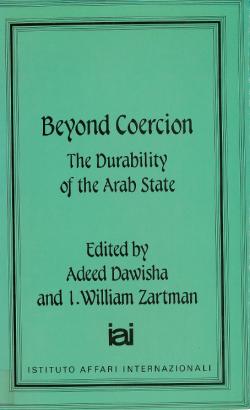Beyond Coercion. The Durability of the Arab State

This volume analyses the process of stabilisation amongst the Arab states, a process that has contradicted all predictions of impending disintegration and impending collapse. Although there were some cases of disintegration, there are evidently mechanisms at work that helped consolidate the majority of Arab states and the Arab state system. Revolutions, as in Iran or the Sudan, or political collapse and disintegration, as in Lebanon, have been highly visible but nevertheless exceptions. This collection, Volume Three in the "Nation, State and Integration in the Arab World" research project carried out by the Istituto Affari Internazionali, focuses on the problem of explaining the stability and persistence of the state in the Arab world.
Third of the four volumes of the series Nation, State and Integration in the Arab World, the product of a three-year collective effort organised by the Istituto Affari Internazionali (IAI). Published also in the series "Routledge Library Editions: Politics of the Middle East" (July 2015, ISBN 978-1-13-892379-9). Chapter 11 already published in The International Spectator, Vol. 20, No. 2 (April-June 1985), p. 3-10. Chapters 1, 3, 5, 7 e 11 published also in Giacomo Luciani (ed.), The Arab State, London, Routledge, 1990.
List of Tables, p. viii
Foreword, p. ix-xi
Introduction, I. William Zartman, p. 1-13
Contemporary Arab Regimes
Definitions of the Concept of the State
Characteristics
Static and Dynamic Theories of Stability
1. Arab Bureaucracies: Expanding Size, Changing Roles, Nazih Ayubi, p. 14-34
1.1. Expanding Size
1.2. Expansion Described
1.3. Why the Expansion?
1.4. Role in Development
2. Political Parties in the Arab State: Libya, Syria, Egypt, Raymond A. Hinnebusch, p. 35-60
2.1. Libya: Charismatic Mobilisation from Above
2.2. Syria: Single Party in a Divided Society
2.3. Egypt: Party Adaptation to a Pluralising Society
2.4. Arab Party Systems: Differences and Similarities
3. Opposition as Support of the State, I. William Zartman, p. 61-87
3.1. Manipulated Pluralism: Morocco
3.2. Controlled Pluralism: Egypt
3.3. Emerging Pluralism: Tunisia
4. Professional Associations and National Integration in the Arab World, with Special Reference to lawyers Associations, Mustapha K. El Sayed, p. 88-115
4.1. Framework for the Study of Interest Groups and Arab Integration
4.2. Method of Study
4.3. Law Associations
4.4. Membership of Bar Associations
4.5. Purpose and Policies
4.6. Public Policies Towards Bar Associations
4.7. Arab Lawyers Union
5. Arab Military in Politics: from Revolutionary Plot to Authoritarian State, Elizabeth Picard, p. 116-146
5.1. Towards the Stabilisation of Arab Military Regimes
5.2. Armed Forces and the State
5.3. The Military and Society
5.4. Military Regimes and Economic Development
6. Role of Religious Institutions in Support of the State, Sadok Belaid, p. 147-163
6.1. General Context
6.2. Partnership: the Arabian Peninsula: Saudi Arabia
6.3. Split: the Maghreb States
6.4. Confrontation: Egypt and Sudan
7. Social Structure and Political Stability: Comparative Evidence from the Algerian, Syrian and Iraqi Cases, Jean Leca, p. 164-202
7.1. Political Stability and Social Structure: a Static Model
7.2. Social Challenges to Political Stability: the Split in the Middle Class and the Dilemmas of Redistribution
7.3. Algeria: 1962-85
7.4. The ‘Corrective’ Movement in Syria: 1970-85
7.5. Iraq: 1963-85
7.6. Conclusion: Class Society, Class Politics and Social Upheavals
8. Social Transformation and Political Power in the Radical Arab States, Rashid Khalidi, p. 203-219
8.1. Changing Ruling Elites
8.2. New and Prosperous Class
8.3. Distance Between Ruler and Ruled
9. Limits of Ruling Elites: Autonomy in Comparative Perspective, Hamid Ansari, p. 220-238
10. Class and the State in Rural Arab Communities, Nicholas Hopkins, p. 239-259
10.1. Testour (Tunisia)
10.2. Musha (Egypt)
10.3. Al-Murrah Bedouin (Saudi Arabia)
11. Arab Regimes: Legitimacy and Foreign Policy, Adeed Dawisha, p. 260-275
12. Conclusion: Reasons for Resilience, Adeed Dawisha, p. 276-283
Bibliography, p. 284-301
About the Authors, p. 302-304
Index, p. 305-310
Topic
Tag
Related content
-
Publication23/08/2015
The Arab State
leggi tutto


